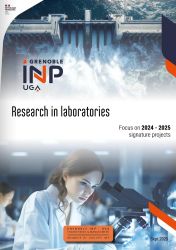In relation to the Alps, the first risks that come to mind are gravitational, i.e. avalanches, landslides and rock falls. At the 3SR laboratory, scientists have developed the world’s first rock stability calculation code including a realistic description of rock joints. “One of the first uses of this code was to verify the stability of the Acropolis cliffs during the Olympic Games in Athens" recalls Félix Darve, Professor at Grenoble INP – Ense3 and researcher at 3SR.

Since then, the laboratory has developed more efficient numerical models according to the “discrete elements” method. One of these models, called YADE, can be applied to grains of sand, boulders or snowflakes. It is typically used to make forecasts on the probable fracture mode of rocky cliffs. Other models are then used to determine the paths of the detached boulders and the impacted areas.
Specific calculations, taking into account the hydromechanic coupling, had to be developed to model landslides. “Moreover, we had to develop a numerical model able to describe the flow after fracture and the changes of the torrential mud slide”. Very promising results have been obtained with the first tests performed on theoretical slopes using the Finite Elements Method with Lagrangian Points (MEFPIL), combining finite elements and a specific method.
Finally, the forecast of avalanches is the main focus of the Snow-White ANR project, aimed at studying the deformation mechanisms of pressurised snow through microtomography at the Grenoble Synchrotron and supplying digital simulation tools.
Specific calculations, taking into account the hydromechanic coupling, had to be developed to model landslides. “Moreover, we had to develop a numerical model able to describe the flow after fracture and the changes of the torrential mud slide”. Very promising results have been obtained with the first tests performed on theoretical slopes using the Finite Elements Method with Lagrangian Points (MEFPIL), combining finite elements and a specific method.
Finally, the forecast of avalanches is the main focus of the Snow-White ANR project, aimed at studying the deformation mechanisms of pressurised snow through microtomography at the Grenoble Synchrotron and supplying digital simulation tools.
SUMMARY
- Grenoble, high potential natural and technological risk management
- Dealing with natural and technological risks
- Falling boulders and snow
- An earthquake-prone area, vulnerable structures
- Water, the main risk factor
- Rocks: custodians of radioactive waste
- Coastal risks at the centre of LEGI research
- Several training courses including a MOOC!





